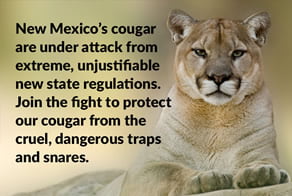Trapping FAQs – Frequently Asked Questions
Introduction
Are Modern Trapping Techniques Selective and Do They Minimize Suffering?
Is Trapping Closely Regulated?
Is Trapping Necessary to Keep Wildlife Populations in Balance?
Does Trapping Control Wildlife Disease?
If Trapping is Prohibited, Won’t Hunting Be Next?
Are People and Companion Animals Harmed by Traps?
Don’t Trapping License Fees Support Conservation?
Isn’t Wild-caught Fur a Sustainable and Environmentally Friendly Resource?
References
Download this FAQ on Trapping [1.4 MB PDF]
Introduction
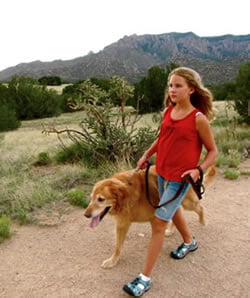
To save time, trappers may set traps close to trails, roads, and campgrounds, which can expose people and pets to dangerous traps. Photo courtesy Cat Cannon.
The majority of people who recreate on public lands do so to hike, camp, observe wildlife, take photographs, and enjoy natural values. Those objectives are frustrated by the presence of hidden, baited steel jaw traps, steel cable strangulation snares, and poisons. Because of their indiscriminate nature, traps pose a serious, ongoing threat to public lands users and their companion animals. Traps kill wildlife indiscriminately. Endangered species such as Mexican wolves, wolverines, and lynx are caught and killed by traps, harming both individual animals and entire wildlife populations.
Are Modern Trapping Techniques Selective and Do They Minimize Suffering?
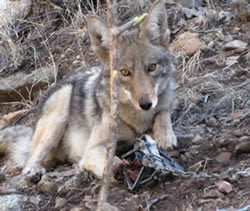
Trapped animals fight for their freedom and many sustain catastrophic injuries while trapped. Photo courtesy Mary Katherine Ray, Sierra Club.
Animal traps fall under two categories: restraining or killing. Restraining traps hold the animal until the trapper arrives to kill it. Kill traps are designed to cause immediate death and are used either terrestrially or underwater. The terrestrial traps snap the neck or spine of captured animals. Traps do not discriminate between similar species and often catch non-target animals. Despite numerous modifications most traps can cause serious injury and suffering, including broken legs, dislocated shoulders, lacerations, torn muscles, cuts to mouths and gums, broken teeth, fractures, amputation of digits, and even death. An animal trapped on land may suffer from psychological stress and/or pain, starvation, dehydration or predation. If captured in aquatic traps, animals adapted to swimming and diving for long periods such as beavers and river otters, can slowly suffer from hypoxia even if they struggle before drowning. The “padded” leghold trap, touted as the humane alternative to the steel-jaw version, still causes significant injuries to numerous of species. And although trapping proponents claim the “padded” leghold traps are humane, trap-use surveys indicate that less than 3 percent of U.S. trappers even own one.
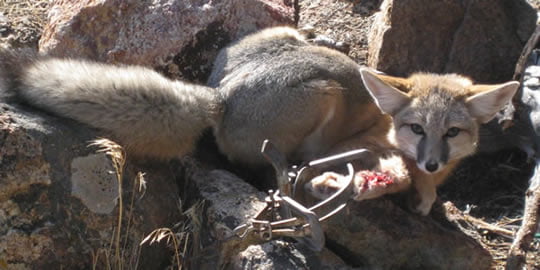
Despite their precariously low numbers, swift foxes are still trapped even as their pelts are practically worthless on global fur markets.
Conibear traps, intended to kill animals instantly by snapping the spinal column at the base of the neck, have frequent mis-strikes and injured animals frequently escape from them. Studies show that Conibear traps generally kill less than 15 percent of trapped animals instantly and more than 40 percent usually die slow, painful deaths as unintended body parts such as abdomens, heads or limbs are smashed and crushed between the trap bars. Field studies of the Conibear 120 Magnum (used to trap small animals such as minks and pine martens) have shown that non-targeted species constitute more than 73 percent of all captures. The American Veterinary Medical Association (AVMA) does not consider so-called “kill traps” to be humane, because such traps do not always render “a rapid or stress free death” consistent with the AVMA’s criteria for euthanasia. Other information shows that between 2 and 10 non-targeted animals are trapped for every target animal captured. Still other studies found that non- targeted animals constitute between 56 percent and 76 percent of leghold trap captures. An undercover investigation in New Mexico by Born Free USA in 2011 documented that New Mexico trappers had unintentionally caught cougar cubs and black bears in leghold traps; both of these species are off-limits for trapping in New Mexico and almost all other states. Trappers are concerned with undamaged pelts, but not quick and/or humane deaths. Born Free USA’s investigation also documented trappers in New Mexico strangling, drowning and chest stomping animals caught in traps to avoid damaging their pelts.
Is Trapping Closely Regulated?
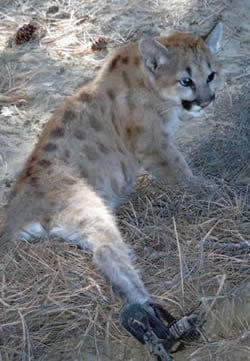
While most states do not allow for take of cougar kittens, traps do not discriminate between species. A cougar kitten, even if released, may be orphaned and die of starvation. Photo: Born Free USA/Respect for Animals.
Very few states closely monitor populations of animals trapped each year. While some states mandate that trappers report their trapping kills, compliance remains uneven. Moreover, these reports may not account for non-targeted animals captured or killed, including companion animals. Finally, while capture reports can help provide some estimate of the number and type of species killed annually, the fact is that no matter how accurate the kill data, they do not reflect population trends or demographic (species, age and sex) information. Accurate population monitoring would require a multilayered monitoring program capable of tracking population trends of all exploited species—most states do not have these monitors in place. Trappers often place their traps on public lands, including on U.S. Forest Service, Bureau of Land Management and state trust lands. Traps may be set almost anywhere. While states typically have mandatory set back distances from roads, trails and other human facilities, companion animals are often still trapped. Neither trappers nor land management agencies are required to share information on trap placement or post warning signs that trapping is occurring in a local area.
Is Trapping Necessary to Keep Wildlife Populations in Balance?
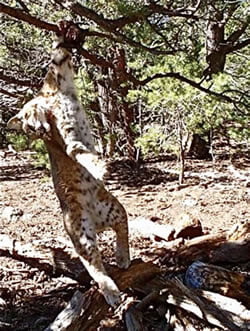
Bobcat pelts are highly valued in global fur markets and have spurred an escalation of trapping across the United States. Photo: Born Free USA/Respect for Animals.
Trappers often claim that trapping prevents wild animals from “overpopulating” and “destroying” their habitat by removing “surplus” animals from the wild. In nature, however, animal populations are largely regulated by food and habitat availability, which naturally influence reproduction and survival. Consider how wildlife species that are not subject to human-induced “control” or exploitation manage to stay in balance with the environment such as the least chipmunk, banner-tailed and kangaroo rats and even carnivores like owls and eagles. Indeed, the notion of “surplus animal” is a misnomer: every animal, alive or dead, is of use to itself, its species, and other organisms in the ecosystem. Furthermore, trappers do not prize animals culled naturally—typically the ill, aged, infirm and very young. Instead, trappers work against natural selection by removing the healthiest animals with the best fur, and discarding the unhealthy ones as “by catch.” In addition, many states have no bag limits (that is, trappers can kill as many animals as they can capture) such as in Colorado and New Mexico. The number of animals killed by trapping is not driven or dictated by wildlife populations or management objectives. It is largely driven by demand and commercial fur prices. If fur prices rise, trapping increases, and the number of furbearing animals (and non-target species) removed from the ecosystem increases. Removing massive numbers of bobcats, coyotes and foxes ecologically “releases“ prey species such as rats, mice, rabbits and squirrels. This irruption can result in decreased forage, thereby negatively affecting populations of other herbivorous animals such as deer and other large ungulates, which are competitors for forage. In short, trapping, which is non-selective and market driven, disrupts natural population cycles and is contrary to the goal of preserving natural systems.
Does Trapping Control Wildlife Disease?
According to the Centers for Disease Control, the National Academy of Sciences (NAS) and the World Health Organization, as well as numerous other scientific, public health and veterinary organizations, there is no scientific evidence that trapping controls the spread of disease such as rabies. In 1973, the NAS subcommittee on rabies concluded:
Persistent trapping or poisoning campaigns, as a means to control rabies, should be abolished. There is no evidence that these costly and politically attractive programs reduce either wildlife reservoirs or rabies incidence. The money can be better spent on research, vaccination, and compensation to stockmen for losses, and education and warning systems.
In fact, researchers have discovered that trapping may actually exacerbate the spread of disease. By removing mature, immune animals, trappers reduce competition for habitat and make room for newcomers who may not be immune or may even be carriers of disease. In addition, animals infected with rabies do not eat in the latter stages of the disease and thus do not respond to baited traps. Hence, traps set will more often capture healthy animals rather than infected animals.
If Trapping is Prohibited on Public Land, Won’t Hunting Be Next?
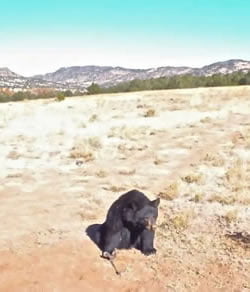
Many states do not permit bear trapping, but this black bear was incidentally trapped in New Mexico. Photo: Born Free USA/Respect for Animals.
No. Hunting and trapping are regulated differently. Trapping, for instance, allows one to profit from the public’s wildlife. Hunters are subject to far more restrictions than trappers. Many hunters and wildlife professionals support additional trapping restrictions. Muth et al. (2006) surveyed 3,127 conservation professionals who were members of the American Fisheries Society, Society for Conservation Biology, North American Wildlife Enforcement Officers’ Association, and The Wildlife Society. Asked whether leg-hold traps should be banned, respondents indicated yes by 46 percent, no by 39 percent, and no opinion by 15 percent. Further, the leg-hold trap ban was favored by 59 percent of people employed in the private sector, in higher education institutions, and nongovernmental organizations. These professionals cited pain and stress, and harm to non-target species as the two primary reasons for favoring a trapping ban. Secondary reasons included the uselessness of trapping to wildlife management, conflicts with public values, and concerns about trapping being unethical. Trapping proponents favored its efficiency, believing it had no effect on furbearer populations. Of the respondents that hunted or trapped, 80 percent indicated that they thought leg- hold traps could harm or kill non-target species—including expensive hunting hounds.
Are People and Companion Animals Harmed by Traps?
There are many documented cases of pets and people becoming caught in traps, as well as people being injured while attempting to release a trapped animal. No official medical database exists that tracks human- trap injuries (including severity or numbers) and most states do not require that trappers report non-targeted catches, including pets, which may either be injured or killed by a trap.
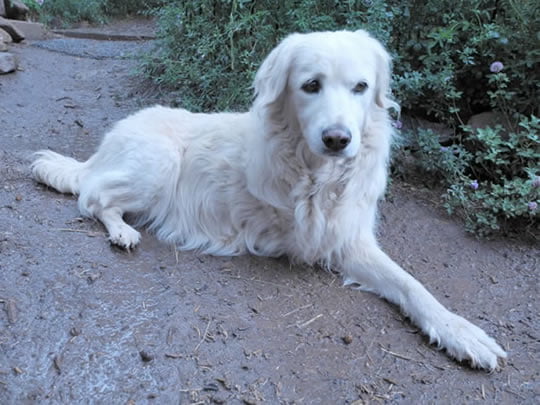
Dogs caught in traps commonly require amputation surgeries or other treatment for their injuries. Photo by Charles Fox.
Non-governmental organizations have attempted to track negative human encounters with traps. Most incidents have resulted indirectly from operations to rescue cats or dogs caught in traps. Trapped dogs experience stress when trapped, which results in dogs biting at the trap and everything within reach, including rescuers. Groups have recorded a number of incidents where public lands users found trapped animals and experienced trauma from what they witnessed.
Prohibiting the use of indiscriminate traps will balance management with the expectations of the majority of the public and will help ensure public safety. It will also protect individuals from enduring the emotional and financial strain of dealing with the loss or injury of their companion animals to the jaws of a trap.
Don’t Trapping License Fees Support Conservation?
Killing animals does not conserve them. Trappers pay nominal fees to state wildlife agencies for the privilege of trapping. In New Mexico a trapping license costs just $20 and imposes no limit on the number of animals killed. Little of that money is used for habitat conservation, while most of it supports staff salaries and program administration. In fact, trapping is subsidized by hunting and angling, even while trapped wild animal populations go unmonitored.
Isn’t Wild-caught Fur a Sustainable and Environmentally Friendly Resource?

Nearly trapped to extinction in the past, the badger is still subject to persecution. Photo: Born Free USA/Respect for Animals.
Placing humane concerns aside, there are many reasons that fur could never be considered “responsible,” “sustainable” or “environmentally friendly.” Environmentally harmful chemicals including chromium and formaldehyde are used in the processing and tanning of fur garments to prevent them from decomposing. The Industrial Pollution Projection System rates the fur dressing and dyeing industry as one of the five worst industries for toxic metal pollution. In 1991, six New Jersey fur processors/ tanners were fined more than 2 million dollars for releasing toxic waste into the environment. Tanneries more than any other business are on the Environmental Protection Agency’s Superfund list that identifies priority environmental contamination sites. In addition, trappers use a tremendous amount of gasoline to regularly check their miles of trap lines to remove dead and dying animals and reset the traps. This is one reason why, compared to a faux fur coat, it takes nearly 3 times more energy to produce a fur coat from trapped animals. Lastly, traps set to catch wild furbearing animals are notoriously indiscriminate, often catching “non-target” animals including juveniles, protected species such as cougar kittens (pictured above), and threatened and endangered species—far from being environmentally friendly.
References
Introduction U.S. Department of the Interior, Fish and Wildlife Service; U.S. Department of Commerce, U.S. Census Bureau. 2007. 2006 National Survey of Fishing, Hunting, and Wildlife-Associated Recreation.
FAQ1 Iossa, G., C. D. Soulsbury, and S. Harris. 2007. Mammal trapping: a review of animal welfare standards of killing and restraining traps. Animal Welfare 16: 335-352. Harris, S., C. D. Soulsbury, and G. Iossa. 2005. Trapped by Bad Science: The Myths behind the International Humane Trapping Standards: A Scientific Review. International Fund for Animal Welfare. Gilbert, F. F. and N. Gofton. 1982. Terminal dives in mink, muskrat and beaver. Physiology & Behavior 28(5): 835- 840. Phillips, R. L., et al. 1990. Leg injuries to coyotes in three types of foothold traps. Wildlife Society Bulletin 18: 166-175. International Association of Fish and Wildlife Agencies Fur Resources Technical Committee. 1993. Ownership and use of traps by trappers in the United States in 1992. Fur Resources Technical Committee of the International Fish and Wildlife Agencies and the Gallup Organization, Washington, D.C. Lunn, H. C. 1973, The Conibear Trap-Recommendations for its Improvement. Humane Trap Development Committee of Canada, Canadian Federation of Humane Societies. Proulx, G. and M. W. Barrett. 1993. Field testing the C120 Magnum for mink. Wildlife Society Bulletin 21: 421- 426. American Veterinary Medical Association. 2007. AVMA Guidelines on Euthanasia. Tomsa, T. N. and J. E. Forbes. 1990. Coyote Depredation Control in New York – An Integrated Approach. USDA-Animal Plant Health Inspection Service. Randall, D. 1975. Hearings before the Ninety Forth Congress to Discourage the Use of Painful Devices in the Trapping of Animals and Birds. U.S. Govt. Printing Office. Washinton.D.C. Tullar, B. F. 1984. Evaluation of a padded leg-hold trap for capturing foxes and raccoons. NY Fish and Game Journal 31: 97-103. Onderka, D.K., et al. 1990. Injuries to coyotes and other species caused by four models of footholding devices. Wildlife Society Bulletin 16: 303-307. Beasom, S. L. 1974. Selectivity of predator control techniques in south Texas. Journal of Wildlife Management 38:837-844. Novak, M. 1987. Traps and trap research. Pages 941-969 in M. Novak, J. A. Baker, M. E. Obbard, and B. Malloch (eds.). WILD FURBEARER MANAGEMENT AND CONSERVATION IN NORTH AMERICA. Ontario Trappers Association. North Bay, Ontario, Canada. Born Free USA www.bornfreeusa.org/victimsofvanity.
FAQ 3 Krebs C. J. 1994 Natural Regulation of Population Size. Pages 332-348inEcology: The Experimental Analysis of Distribution and Abundance. Fourth Edition.
FAQ 4 “Control of Rabies,” National Research Council, Subcommittee on Rabies, National Academy of Sciences, Washington, D.C., 1973. Choisy M. and P. Rohani. 2006. Harvesting can increase severity of wildlife disease epidemics. Proc.R.Soc.B 273: 2025-2034 “Controlling Wildlife Rabies through Population Reduction: An Ineffective Method,” The Rabies Monitor, Vol. 4, No.1, Spring 1996.
FAQ 5 Muth, R. M., R. R. Zwick, M. E. Mather, J. F. Organ, J. J. Daigle, and S. A. Jonker. 2006. Unnecessary source of pain and suffering or necessary management tool: Attitudes of conservation professionals toward outlawing leghold traps. Wildlife Society Bulletin 34: 706-715.
FAQ 8 Hettige, H., P. Martin, M. Singh, and D. Wheeler. 1994. “The Industrial Pollution Projection System.” World Bank Policy Research Working Paper #1431 (Part 1). EPS Seeks $2.2 Million in Penalties from Six NJ Firms in the Fur Industry for Hazardous Waste Violations. U.S. Environmental Protection Agency News Release, New York: 8 October, 1991. Smith, G. H. 1979. Energy Study of Real vs. Synthetic Furs. University of Michigan.
 Know Your NM State Legislators!
Know Your NM State Legislators!
Your New Mexico state Senator and Representative have the power to ban traps, snares and poisons on public lands. Find out who they are and let them know you oppose trapping on public lands. A simple phone call and email can make all the difference.
People's Forum Panel Report on Public Lands Trapping
The New Mexico Legislature should ban trapping on public lands in New Mexico because traps harm people, animal companions, and whole populations of wildlife including rare species. Most New Mexican voters believe that trapping is cruel and unnecessary.
TrapFree Friends
Animal Protection Voters
Black Bear Bureau
Footloose Montana
Fur Free Alliance
Furbearer Defenders
League of Humane Voters
Lobos of the Southwest
Mercy for Animals
National Urban Wildlife Coalition
No Cruel Traps on Public Lands
People's Forum Panel on New Mexico Public Lands Trapping
Predator Defense
Project Coyote
Pulling for Life
TrailSafe Nevada
Trap Free Montana
TrapFree Oregon
Wyoming Untrapped

